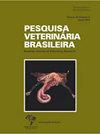寻找奶牛乳头病变中牛乳头瘤病毒的存在
IF 0.8
4区 农林科学
Q3 VETERINARY SCIENCES
引用次数: 1
摘要
本文章由计算机程序翻译,如有差异,请以英文原文为准。
Searching bovine papillomavirus presence in lesions seen on teats of cows
ABSTRACT: The samples were taken from 106 cows with various-looking lesions on their teats and ranged in age from 2 to 8 years. Enzyme-linked immunosorbent assay (ELISA) antigen (Ag) positive for the bovine papillomavirus (BPV) was found in 59 (55.7%) blood serum samples. PCR using FAP59/64 primers was positive for 24 (22.6%) samples. BPV-2 (40, 37.7%), BPV-6 (28, 26.4%), BPV-8 (30, 28.3%), BPV-9 (36, 34%), BPV-10 (32, 30.3%), and BPV-12 (22, 20.8%) were found in a PCR type-specific analysis of single and mixed type teat warts. The highest positivity was observed in BPV-2, BPV-9 and BPV-10 in flat and round forms, BPV-6, BPV-10, BPV-12, and mixed types in rice grain-cauliflower forms, BPV-9 and mixed types in filiform in the distribution of types based on the macroscopic appearance of teat lesions. As for the distribution of BPV types according to age, the most BPV-2 types were found in the age group of two years, the most BPV-10 types in the age group of three years, the most BPV-9 types in the age group of four years, the most BPV-8+BPV-12 types in the age group of five years, and the most mixed types between the ages of six and eight years. The existence of the virus was then checked using electron microscopy on the chosen samples (at least one investigation was conducted), and it was positively identified using BPV type-specific primers. The authors concluded that BPV detection using an ELISA (Ag) test from blood serum samples was shown to be less sensitive than BPV type-specific PCR from wart samples.
求助全文
通过发布文献求助,成功后即可免费获取论文全文。
去求助
来源期刊

Pesquisa Veterinaria Brasileira
农林科学-兽医学
CiteScore
1.30
自引率
16.70%
发文量
41
审稿时长
9-18 weeks
期刊介绍:
Pesquisa Veterinária Brasileira - Brazilian Journal of Veterinary Research (http://www.pvb.com.br), edited by the Brazilian College of Animal Pathology in partnership with the Brazilian Agricultural Research Organization (Embrapa) and in collaboration with other veterinary scientific associations, publishes original papers on animal diseases and related subjects. Critical review articles should be written in support of original investigation. The editors assume that papers submitted are not being considered for publication in other journals and do not contain material which has already been published. Submitted papers are peer reviewed.
The abbreviated title of Pesquisa Veterinária Brasileira is Pesqui. Vet. Bras.
 求助内容:
求助内容: 应助结果提醒方式:
应助结果提醒方式:


